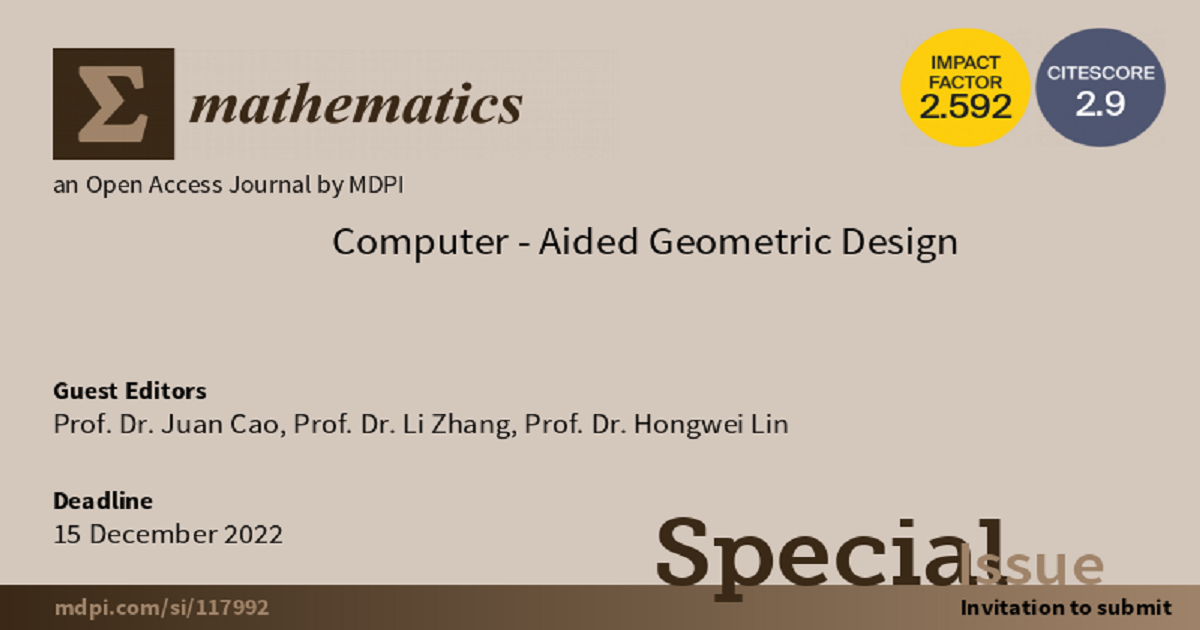Computer-Aided Geometric Design
A special issue of Mathematics (ISSN 2227-7390). This special issue belongs to the section "Mathematics and Computer Science".
Deadline for manuscript submissions: closed (15 March 2023) | Viewed by 24523

Special Issue Editors
Interests: computer aided geometric design
Interests: computer aided geometric design
Special Issue Information
Dear Colleagues,
In the past two decades, some new methods and new directions have emerged in the field of computer-aided geometric design (CAGD). Firstly, the development of new methods such as the geometric iteration method and progressive iterative approximation bring convenience to the modeling of curves and surfaces. Secondly, with the in-depth study of isogeometric analysis, the study of trivariate parametric solids suitable for analysis and manufacturing has become a new research direction in CAGD. Finally, the development of computational topology has provided strong theoretical support and technical tools for topology control in geometric modeling, and novel technologies such as topology-aware reconstruction methods have emerged. This Special Issue deals with the aforementioned new methods and new directions that have emerged in CAGD, including but not limited to geometric iteration, progressive-iterative approximation, analysis-suitable and manufacturing-suitable trivariate parametric solid modeling, topology-aware modeling, etc. The editors of this Special Issue invite authors to submit their original research papers dealing with but not limited to those fields.
Prof. Dr. Juan Cao
Prof. Dr. Li Zhang
Prof. Dr. Hongwei Lin
Guest Editors
Manuscript Submission Information
Manuscripts should be submitted online at www.mdpi.com by registering and logging in to this website. Once you are registered, click here to go to the submission form. Manuscripts can be submitted until the deadline. All submissions that pass pre-check are peer-reviewed. Accepted papers will be published continuously in the journal (as soon as accepted) and will be listed together on the special issue website. Research articles, review articles as well as short communications are invited. For planned papers, a title and short abstract (about 100 words) can be sent to the Editorial Office for announcement on this website.
Submitted manuscripts should not have been published previously, nor be under consideration for publication elsewhere (except conference proceedings papers). All manuscripts are thoroughly refereed through a single-blind peer-review process. A guide for authors and other relevant information for submission of manuscripts is available on the Instructions for Authors page. Mathematics is an international peer-reviewed open access semimonthly journal published by MDPI.
Please visit the Instructions for Authors page before submitting a manuscript. The Article Processing Charge (APC) for publication in this open access journal is 2600 CHF (Swiss Francs). Submitted papers should be well formatted and use good English. Authors may use MDPI's English editing service prior to publication or during author revisions.
Keywords
- geometric iteration method
- progressive–iterative approximation
- analysis-suitable trivariate parametric solid modeling
- manufacturing-suitable trivariate parametric solid modeling
- isogeometric analysis
- topology-aware modeling
- topological design
- curve and surface design
Benefits of Publishing in a Special Issue
- Ease of navigation: Grouping papers by topic helps scholars navigate broad scope journals more efficiently.
- Greater discoverability: Special Issues support the reach and impact of scientific research. Articles in Special Issues are more discoverable and cited more frequently.
- Expansion of research network: Special Issues facilitate connections among authors, fostering scientific collaborations.
- External promotion: Articles in Special Issues are often promoted through the journal's social media, increasing their visibility.
- e-Book format: Special Issues with more than 10 articles can be published as dedicated e-books, ensuring wide and rapid dissemination.
Further information on MDPI's Special Issue polices can be found here.





